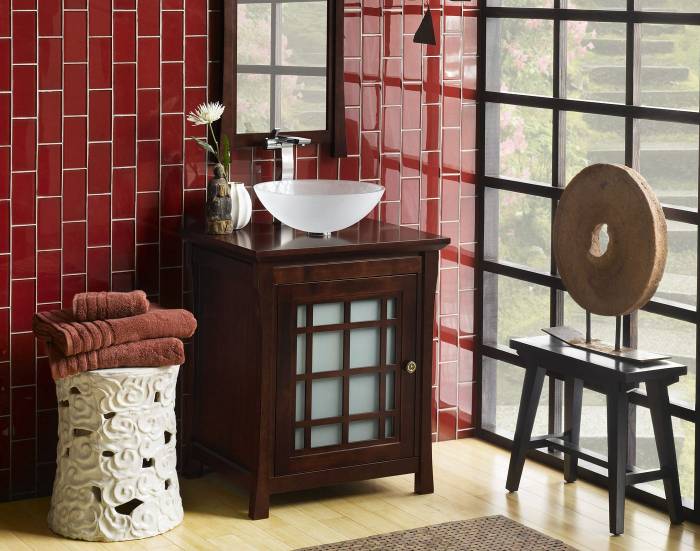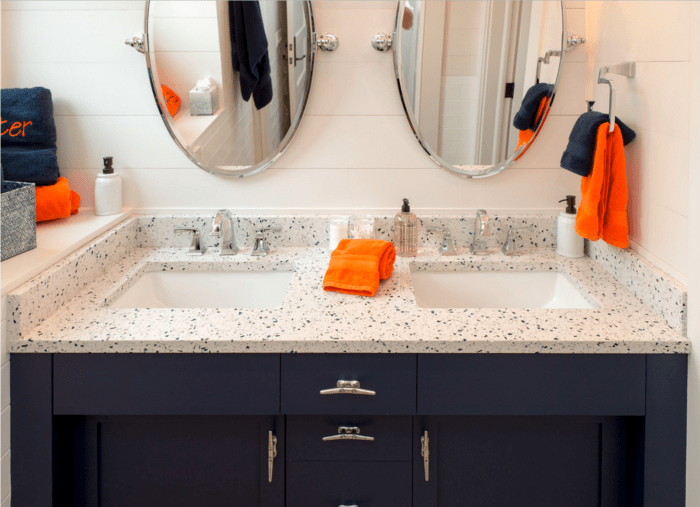In the realm of bathroom design, sustainability is taking center stage. Eco-conscious homeowners are increasingly opting for recycled material bathroom vanities, embracing both style and environmental responsibility. These vanities offer a unique blend of aesthetics and sustainability, transforming bathrooms into spaces that are not only visually appealing but also mindful of our planet’s well-being.
Recycled material bathroom vanities encompass a wide range of materials, each with its own distinct characteristics and environmental advantages. From reclaimed wood to repurposed glass and metal, these materials breathe new life into discarded resources, reducing waste and promoting a circular economy.
Introduction to Recycled Material Bathroom Vanities
In today’s eco-conscious era, bathroom renovations are increasingly embracing sustainable practices. One notable trend is the growing demand for recycled material bathroom vanities, offering a stylish and environmentally friendly alternative to traditional options.
The use of recycled materials in bathroom vanities not only reduces waste but also conserves natural resources. By incorporating recycled wood, metal, glass, or plastic into their designs, manufacturers are contributing to a circular economy that promotes sustainability.
Environmental Benefits
- Reduced Landfill Waste: Recycled materials divert waste from landfills, reducing the environmental impact associated with waste disposal.
- Conservation of Natural Resources: By using recycled materials, manufacturers reduce the need for extracting virgin materials, conserving forests and other natural resources.
- Lower Carbon Footprint: The production of recycled materials typically requires less energy than extracting and processing virgin materials, resulting in a lower carbon footprint.
Types of Recycled Materials Used in Bathroom Vanities
Incorporating recycled materials into bathroom vanities is a testament to sustainable design practices. These materials not only reduce environmental impact but also offer unique aesthetic qualities.
A diverse range of recycled materials finds application in bathroom vanity construction, each boasting distinct properties and sustainability advantages:
Reclaimed Wood
Reclaimed wood, salvaged from old structures or discarded lumber, adds a touch of rustic charm to vanities. Its natural imperfections and patina tell a story of its past life. Moreover, reclaimed wood reduces the demand for newly harvested timber, contributing to forest conservation.
Recycled Metal
Recycled metal, such as aluminum or steel, provides durability and longevity to bathroom vanities. These materials are highly resistant to corrosion and moisture, ensuring the vanity’s resilience in humid bathroom environments. Additionally, recycling metal significantly reduces greenhouse gas emissions compared to extracting and processing virgin ores.
Recycled Glass
Recycled glass, obtained from discarded bottles and jars, adds a touch of sparkle and translucency to vanities. It is a sustainable alternative to traditional glass, as its production requires less energy and raw materials. Moreover, recycled glass helps divert waste from landfills, reducing environmental pollution.
Recycled Plastic
Recycled plastic, derived from post-consumer waste, offers versatility and affordability in bathroom vanity construction. It is resistant to moisture and can be molded into various shapes and designs. By using recycled plastic, manufacturers reduce the demand for virgin plastic, which in turn helps conserve fossil fuels and minimize plastic waste.
Sustainable Composites
Sustainable composites, such as bamboo or cork, combine recycled materials with natural fibers. These composites offer a durable and eco-friendly alternative to traditional wood. Bamboo is a rapidly renewable resource, while cork is harvested from the bark of cork oak trees without harming the tree itself.
Environmental Impact of Recycled Material Bathroom Vanities
Using recycled materials in bathroom vanities significantly reduces environmental impact. Recycled materials divert waste from landfills, conserving natural resources and reducing carbon emissions.
Reduced Carbon Emissions
Recycling materials reduces the need for extracting and processing raw materials, which consumes substantial energy. By using recycled materials, bathroom vanities contribute to lowering carbon emissions. For instance, using recycled wood instead of virgin wood can reduce carbon emissions by up to 30%.
Waste Diversion
Landfills are facing increasing pressure due to the growing waste stream. Recycled materials help divert waste from landfills, extending their lifespan and reducing the environmental impact of waste disposal. By incorporating recycled materials into bathroom vanities, manufacturers contribute to waste reduction and promote a more sustainable waste management system.
Resource Conservation
Using recycled materials conserves natural resources such as timber, water, and minerals. Recycled wood reduces the demand for logging, preserving forests and biodiversity. Recycled plastics and metals conserve non-renewable resources, reducing the environmental impact of resource extraction.
Cost and Availability of Recycled Material Bathroom Vanities
Incorporating recycled material bathroom vanities into your eco-friendly home design comes with cost considerations. Recycled material vanities tend to have a higher price tag compared to traditional vanities made from new materials.
The cost difference stems from the sourcing and processing of recycled materials. Recycled materials often require additional steps in collection, sorting, and preparation before they can be incorporated into vanity designs. This adds to the production costs, which are reflected in the final price.
Cost Comparison
The price range of recycled material bathroom vanities varies depending on the type of recycled material used, the design complexity, and the manufacturer. Generally, expect to pay a premium of 10-20% for recycled material vanities compared to traditional vanities.
Reputable Suppliers and Manufacturers
Finding reputable suppliers and manufacturers of recycled material bathroom vanities is crucial to ensure quality and ethical sourcing. Look for companies that prioritize sustainability in their manufacturing processes and have a proven track record of producing eco-friendly products.
- ReSource Furniture
- EcoFriendlyDigs
- Sustainably Yours
Case Studies of Recycled Material Bathroom Vanities
Incorporating recycled materials into bathroom vanity designs has gained traction among eco-conscious homeowners and designers. Here are some real-world examples of successful bathroom vanity designs that showcase the potential of recycled materials:
Example 1
The Reclaimed Wood Vanity
This vanity, crafted from reclaimed wood, exudes rustic charm. The weathered patina of the wood adds character and depth to the space. The vanity features a sleek and modern design, with clean lines and a floating countertop. The reclaimed wood used in this vanity has a rich history, having once been part of an old barn.
Example 2
The Recycled Glass Vanity
This vanity is a stunning example of how recycled glass can be transformed into a luxurious and functional bathroom fixture. The countertop is made from recycled glass, which has been crushed and fused to create a smooth and durable surface.
The vanity base is made from sustainable wood, creating a cohesive and eco-friendly design.
Example 3
The Upcycled Metal Vanity
This vanity is a testament to the creative potential of upcycling. The base of the vanity is made from an old metal filing cabinet that has been repurposed into a unique and stylish storage solution. The cabinet has been painted in a vibrant color, adding a pop of personality to the bathroom.
The countertop is made from a reclaimed wood slab, creating a harmonious blend of materials.
Conclusion: The Future of Recycled Material Bathroom Vanities
The growing popularity of recycled material bathroom vanities is a testament to the increasing demand for eco-conscious design in the home improvement industry. As consumers become more aware of the environmental impact of their choices, the use of recycled materials in bathroom vanities is expected to continue to grow in the coming years.
Future trends in eco-conscious bathroom design include the use of more sustainable materials, such as bamboo and cork, as well as the incorporation of water-saving features and energy-efficient lighting. As technology advances, we can also expect to see more innovative uses of recycled materials in bathroom vanities, such as the use of recycled glass or plastic in countertops and cabinet doors.
Growing Popularity of Recycled Material Bathroom Vanities
The growing popularity of recycled material bathroom vanities is due to a number of factors, including:
- Increasing consumer demand for eco-friendly products
- Government regulations promoting the use of recycled materials
- Technological advances that make it easier to recycle materials
Future Trends in Eco-Conscious Bathroom Design
Future trends in eco-conscious bathroom design include:
- The use of more sustainable materials, such as bamboo and cork
- The incorporation of water-saving features and energy-efficient lighting
- The use of innovative recycled materials, such as recycled glass or plastic in countertops and cabinet doors
Last Recap
As the demand for sustainable living grows, recycled material bathroom vanities are poised to become the norm in eco-conscious design. Their ability to combine functionality, aesthetics, and environmental responsibility makes them an ideal choice for homeowners seeking to create bathrooms that are both beautiful and sustainable.
As the future of bathroom design unfolds, recycled materials will continue to play a pivotal role, inspiring innovative and environmentally friendly solutions.



